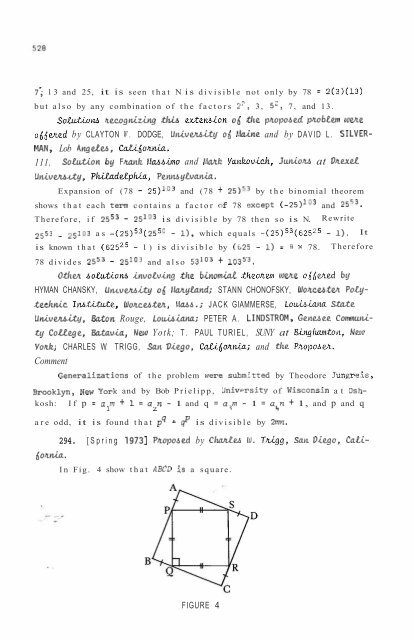You also want an ePaper? Increase the reach of your titles
YUMPU automatically turns print PDFs into web optimized ePapers that Google loves.
7: 13 and 25, it is seen that N is divisible not only by 78 = 2(3)(13)but also by any combination of the factors 2', 3, 5', 7, and 13.S o U o n ~ tecognizing tL.4 e&eaion 06 the ptopobed ptobLan WJL~066e~d by CLAYTON W. DODGE, U~uumLty 06 !.laine and by DAVID L. SILVER-MANy Lob Angdu, C&6otni.a.111. SoUon by Funk. h!U5bhn0 and Almk. Yank.ouich, Juniou at VtudUniuuudy, Phdkddphia, Pen~uyLuanh.Expansion of (78 - 25)lL3 and (78 + 25)53 by the binomial theoremshows that each term contains a factor of 78 txcept (-25)1''3 and w3.Therefore, if 2sS3 - 25173 is divisible by 78 then so is N. Rewrite2553 - ;51:,3 as -(25)53(255c - I), which equals -(2~)~~(625~~ - 1). Itis known that (62sZ5 - 1) is divisible by (L25 - 1) = ? x 78.Therefore78 divides 2sS3 - 25lo3 and also 531° + <strong>10</strong>3~~.0 t h 6oUo1u ~ ~ inuoLving the binomid tl~eotuti tuem o66ehed byHYMAN CHANSKY, UvuumLty 06 AImyLand; STANN CHONOFSKY, Wotca,ta PoLytechnic1nAUute, Wotcatm, blab.; JACK GIAMMERSE, LOLLLLLUVIU S m eUniuwLty, LWon Rouge, Louhiana; PETER A. LINDSTROMy Genuee Co~mnuni-ty CoUege, LWauia, NU Yotk; T. PAUL TURIEL, SUNY at !3ing\mntob1, N ~ uYotk; CHARLES W. TRIGG, Sun Diego, C&dot~%iu; and the Phoj20.4U~.CommentGeneralizaticns of the problem were subm!ttedby Theodore J~n~~eis,Brooklyny New York and by Bob Prielipp, Univ*rsity of \lisconsin at Osh-kosh:If p = a m + 1 = a n - 1 and q = aqm - 1 = a,,n + 1, and p and q1 2are odd, it is found that pq * 8 is divisible by 2mn.294. [Spring 19731 Ptopobcd by C<strong>Mu</strong> [U. Th,Lgg, Sun Diego, CULL-6otni.a.In Fig. 4 show that ABC3 is a square.FIGURE 4Comment by Chy.ton W.Dodge, UnLumiAy 06 !.lalne at 0to1<strong>10</strong>,The solution of the analogous problem for nested equilateral tri-angles appeared in the <strong>No</strong>vember 1970 issue of the f.Jathematics 14aqaaine,Problem 754, pages 280-281.Comment by K, R, S. Sastry, Xakele, Ethio-pia, in the <strong>No</strong>vember 1971 issue indicates that the method of the solutionby 1-Iichael Goldberg holds for any regular polygon.Hence it holds fora square, proving problem 294.SoLuLio~u tume &~o 066aed by ZAZOU KATZ, Beudy H&, Cafi6ot1ua;ALFRED E. NEUMAN, ALph D&a FmtemLty; R. ROBINSON ROWE, Sammento,CaLitjot~ua; and .the Ptopob u.295. [Spring 19731 Ptopobed by /blmay S. K ~ J I I ~ ~ Fotd J I , Scie1tti6.L~Labotatoty , Uembotn, !.liclugan.Determine an equation of a regular dodecagon (the extended sidesare not to be included).SoUon by ,the Ptopob a.The equationNn=lrepresents a 4N-gon.lanx - b,?\ + [cnyn - dnl> = ABy symmetry we trylx - 11 + :x + 11 + lg - 11 + l yAfter sane elementary calculations,a = 5- 1 >, = 2(2+ 6) .+ 11 + ~(1x1 + Iy!) = A .296. [Spring 19731 Ptopobed by SOLOIIIOII (t!. GoLo~nb, U~uuemLty 06SOUZ~I~II Cal56ot1ua, Uejmdmeld 06 ELect~~Lcd E~tginedng.1) Combine 2, 5, and 6 to make four 2's.2) Combine 2, 5, axd 5 to make four 4's.3) Combine 2, 5, and 6 to make four 5's.4) Combine 2, 5, and 6 to make four 7's.5) Combine 1, 5, and 6 to make four 7's.SOLULLOII by ChmLeb (U.In general,6 + 2 - 5=3=(a+a+a)/a;Tfigg, SUII Diego, Cu& 6ot1ua.2(6 - 5) = 2 = a/a + a/a = 6 + 1 - 5;2 + 5 - 6 = 1 = (a/a)(a/a) = aa/aa = a/a + a - a = aa/aa = l(6 - 5);6-5-!2=O=a/a-a/a=a+a-a-u=aa-aa=aa-aa=6 - 5 = 1 ;
















